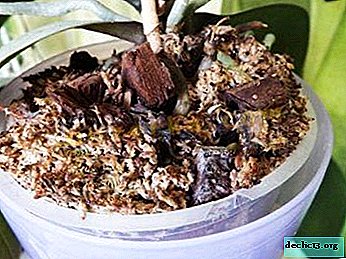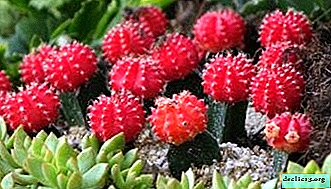12 species of cacti that grow in the desert. Description and photos of plants

In a hot desert under the scorching sun, where, apparently, nothing could survive, cacti stretch upwards.
Cacti are one of the most unusual-looking plants. Their family is diverse.
The main division relates to habitat, because care for them depends on it. This article describes in detail 12 species of cacti that grow in the desert. Let us consider in more detail their features.
Types of desert plants with names and their photos
A large number of domestic cacti are desert. They are not afraid of sudden changes in day and night temperatures, prolonged drought and scarce soils, but they need sunlight to live. There are many types of delicious desert cacti.
Ariocarpus (Ariocarpus)

The genus of cacti Ariocarpus has 6 species. The plant has a very low, flattened spherical stem of a grayish-green color. On the trunks of some species there are white thin stripes. Its entire surface is covered with large, trihedral solid tubercles, in the sinuses of which there is fluff.
Ariocarpus has almost no thorns, only on a tiny areola there is a not very developed thorn.Bell-shaped flowers are:
- reds;
- yellow;
- white.
They appear near the crown of the stem. The short flower tube opens wide.
Gymnocalycium (Gymnocalycium)

The desert cactus Gymnocalicium in Latin is called "gymnos" and "calycium". Translated into Russian "naked" and "calyx".
The plant received this name because of the bare tubes of flowers, covered with a large number of smooth scales. In this they differ from many representatives of desert cacti.The stem of the Gymnocalycium may be:
- Gray;
- brown;
- green.
The ribs are divided by transverse bumps. There are very interesting varieties in which there is no chlorophyll. The color of these varieties of the Gymnocalicium is:
- pink;
- yellow;
- red.
Cleistocactus (Cleistocactus)

Desert cactus Cleistocactus, when translated from Latin Cleistocactus means "closed". He was named so for the peculiarity of flowers that have a tubular shape, which are almost not opened. Gluecactus has long cylindrical stems and thin thick spines.. They are distinguished by rich flowering. An interesting variety of this cactus is Strauss Cleistocactus. It is unpretentious and does not require special care, and exotic column-shaped stems organically fit into the modern interior.
Mammillaria

A very common type of desert cactus is Mammillaria. His stems are collected in round and small groups. Mammillaria stands out with its not sharp spikes. It blooms with small flowers of various shades, forming a spiral on the tops.
We offer you to watch a video about the Mammillaria cactus:
Parody (Parodia)

Desert cactus Parody grows in small sizes - from 15 to 20 cm. Depending on the species, the stem, for example, spherical or short, is cylindrical. Parody blooms for a very long time. The ribs are twisted in a spiral, they are divided into tubercles.
Flowers are different in color:
- copper red;
- fiery red;
- golden yellow.
Matucana

The genus of desert cacti Matucana got its name in honor of the Peruvian province. It has about 20 species of plants.
The original Matukana cacti stand out for their spherical stem, which, when growing, becomes columnar. The plant grows to a height of 30 cm. It forms lateral shoots.Ribs in this type of cactus are from 21 to 30 pieces, they:
- tuberous;
- low
- arranged in a spiral.
Five centimeter long radial spines, of which there are from 15 to 30, can be straight or curved. They are painted white, black, gray or tan.
There may not be central spines, and if there are, then there are 10 of them 1-7 cm long, in color and shape they coincide with radial ones. Blossoms Matukana flowers in the form of a funnel. There are bright pink, red or crimson flowers. Green spherical fruits have a pink color.
Lophophora

Lofofora Desert Cactus Homeland Central Mexico. The plant stands out in what looks like a pumpkin. On the rounded stem of this cactus there are practically no thorns, the surface is smooth.
It is strictly forbidden to collect cacti in the natural habitat of Lofofora cactus. The reason is the ability of plant juice to cause hallucinations.One of the most interesting varieties of this cactus is Lofofor Williams. It is of particular interest to gardeners, and the juice of this plant has a healing and tonic effect.
Rebucia (Rebutia)

Rebusius cacti are small plants that grow in groups. They are covered with spikes with a spherical stem. On the surface in the form of a spiral are ribs of small height. Rebucia is characterized by abundant flowering. In this case, the flowers at the bottom of the stem form something like a spiral. You will learn more about all types of this plant by reading this article.
Cephalocereus

Cephalocereus is the most unusual and original cactus. It stands out with very thin long white, sometimes wavy spines. Due to this feature, people call this cactus "the head of an old man." It must be borne in mind that he is quite painfully pricked.
In a room, the plant will not bloom. He is appreciated for the light green straight cylindrical stem. Cephalocereus grows bush, over time it becomes stiff. It will take a long time to wait for the side shoots. They grow parallel to the main stem. Cactus ribs are low and straight.
Under natural conditions, adult plants bloom in creamy flowers that exude an unpleasant odor. In appearance, the flowers look like a funnel, pollinated mainly by bats.Aporocactus (Aporocactus)

Aporocactus is one of the simplest Mexican branching species of cacti.whose stems form bushes. This type of plant is unstable to elevated temperatures. Its thin stalks hanging down are painted in bright green color. They are plentifully covered with needles. Along the stem are large colorful pink flowers. Flowering lasts only 4 days.
We offer you to watch a video about the Aporocactus cactus:
Opuntia (Opuntia vulgaris)

The perennial plant of Opuntia in vivo can be:
- branching shrub;
- 6 meter tree;
- creeping plant on the ground.
The stem is mostly juicy, elongated and branched. Prickly pears grow quickly and often form bizarre bushes. This type of cactus is distinguished by the ability to form fresh shoots and flowers from its fruits. However, the seeds in them are not tied. There are white small thorns. Prickly pears on the windowsills do not bloom.
Ferocactus (Ferocactus)

In a desert cactus, Ferocactus stems resemble barrels, in which ribs and powerful spines are strongly pronounced. The height of the highest trunks is 3 meters and a diameter of about 50 cm. The strongly flattened main spines are crooked.
Bell-shaped flowers come in:
- reds;
- orange
- yellow.
Their diameter and length is 2-6 centimeters. Flowers appear at the very top of the cactus. A description of all types of Ferocactus can be found in a separate material.
Epiphyllum

Epiphytic desert cactus Epiphyllum resembles a bush, because it has a lignified base, as well as a fleshy leaf-shaped trunk, on which there are notches. The long stems of this species of plant are mostly down. Epiphyllum is distinguished by the fact that its stems look like greasy green leaves.
They are flat, narrow or trihedral and mainly with wavy edges. There are thorns at the ends of the stems. Cactus blooms in large, strong-smelling flowers..
Why do flowers survive in such conditions and how do they grow?
In the desert, cacti can survive because they lack leaves, and due to their fleshy stems, moisture evaporates very little. In addition, the presence of grooves on the stems allows them to swell when soaking up water during the rainy season.Great importance in terms of cactus survival in the desert is given to thorns. They do not allow animals to eat this plant. In addition to protection, spines and hairs collect moisture. They are able to absorb droplets of water settling in the form of dew. For most desert cactus species, this is the only way to extract moisture in arid areas.
For a long time, desert cacti adorned exclusively these lands. However, today they can often be found at home with lovers of these plants. This is evidence that desert cactus species adapt well to different living conditions.

















